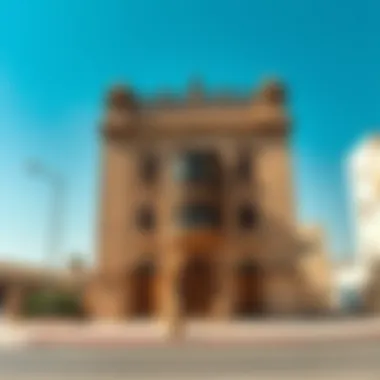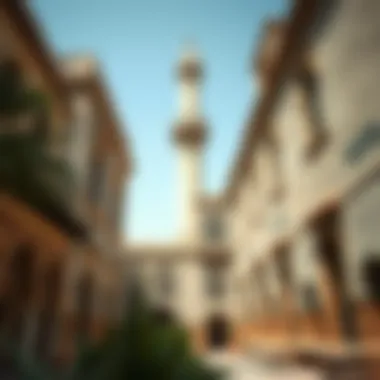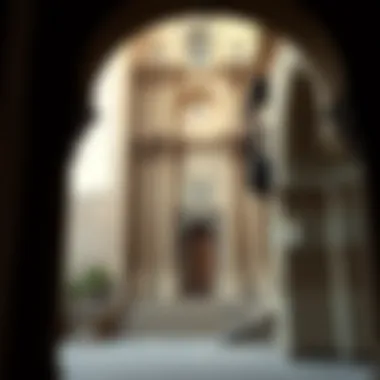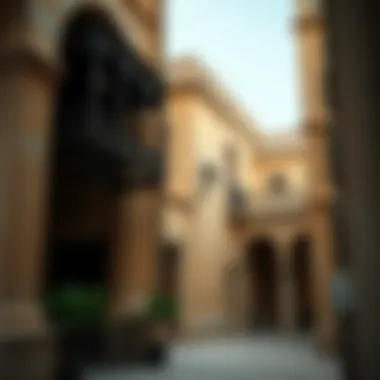Exploring Dubai's Architectural Heritage and Old Buildings


Intro
Dubai has metamorphosed from a modest fishing village into a global metropolis within a few decades. However, amidst the skyscrapers and contemporary designs, the old buildings whisper tales of the city’s rich history, cultural nuances, and architectural brilliance. These structures provide a snapshot of the past, telling us about the life, struggles, and dreams of those who walked these streets long before today’s skyscrapers touched the clouds.
Understanding the architectural heritage of these old buildings is essential for grasping Dubai's identity. They are like books filled with stories, memories, and lessons waiting to be explored. This exploration reveals not only the aesthetic appeal of these buildings but also their significance in the context of a rapidly modernizing city. The conversation around these heritage sites is not just about preservation but about sustaining the essence of what makes Dubai unique.
As we journey through this narrative, we will delve into various aspects, illuminating how these structures hold the key to the past while also influencing present-day Dubai. From their architectural styles to the ongoing restoration efforts, we will uncover the relevance of these buildings in today’s urban landscape. This article aims to unravel the layers of history and significance tied to Dubai's old buildings, showcasing their role in shaping the city’s character in an era defined by growth and evolution.
Historical Context of Dubai's Old Architecture
Understanding the historical context of Dubai's old architecture isn’t just about bricks and mortar; it unveils the rich tapestry of the region's past. Several factors shaped the built environment, reflecting the socio-economic and cultural fabric of the time. Old buildings are more than mere structures; they tell stories of survival, adaptation, and evolution in a landscape that has transformed drastically over the years.
Early Settlement and Traditional Building Techniques
The early settlers in Dubai were largely dependent on the resources available to them, which significantly influenced their building techniques. The use of coral stones and gypsum, materials that were locally sourced, established a distinctive architectural style that married functionality with environmental harmony. For instance, the Barjeel or wind towers were an innovative solution to the extreme heat, creating natural ventilation by guiding the wind through buildings. This adaptation not only illustrates the ingenuity of early inhabitants but also sets a precedent for sustainable building practices.
Communities often banded together to construct homes that were not only protective structures but also communal spaces. The simplicity of design belied the sophistication behind these traditional techniques, which were passed down through generations. The craftsmanship involved in these early buildings continues to inspire modern architects who seek to incorporate elements from the past into contemporary designs.
The Influence of Trade and Commerce
As Dubai grew into a bustling trade hub, its architectural landscape evolved in tandem. The strategic location along trade routes attracted merchants from far and wide, leading to a blend of diverse architectural influences. The city's skyline began to reflect this amalgamation, with traders introducing new styles and technologies that were often adapted to local needs.
Understandably, the merchant class built larger homes, showcasing their wealth and status. Homes in the Al Fahidi district, for example, featured elaborate plasterwork and intricate wooden doors, illustrating the connection between wealth and architectural opulence. The influx of different cultures through trade fostered an environment ripe for architectural experimentation, allowing for a unique style to flourish.
Conversely, commercial architecture, such as souks and warehouses, was designed with functionality in mind. The marketplaces were bustling centers of activity, made to accommodate the mercantile spirit of the time. Structures like the Dubai Creek area highlighted the integration of design and utility, where buildings supported not only economic transactions but the community's cultural exchange.
Cultural Exchange Through Architecture
Dubai's architectural heritage serves as a testament to the cultural exchanges that have occurred throughout its history. Each building echoes the stories of the people who built and inhabited them. This blend signifies not only trade but also the mingling of civilizations. For instance, the incorporation of Mughal and Persian influences is evident in styles such as the intricately detailed Mashrabiya, which allows light and air to flow while providing privacy.
The cross-pollination of ideas ensured that architecture was not static; instead, it evolved continuously. It’s essential to recognize how buildings served as conduits for cultural dialogue. As groups settled in the area, their architectural preferences influenced local traditions, resulting in hybrid styles that enriched the city's landscape.
It is with this cultural lens that one can appreciate Dubai's older buildings—not just as historical structures, but as living embodiments of collective memory.
"Dubai’s architectural narrative is not merely a chronology of bricks; it’s a dynamic story of people, their migrations, and interactions across borders, woven into the very fabric of each building."
The understanding of this historical context not only enhances appreciation among investors and buyers today but also underscores the need for careful preservation as Dubai strides confidently into the future.
Key Architectural Styles in Old Dubai
Understanding the architectural styles of old Dubai is paramount for grasping the city's identity. Each style not only tells a story but also reflects the cultural and historical influences that shaped the region. From Islamic motifs to the elegant touches of Persian means, Dubai's old buildings are a fusion of various traditions. Exploring these key styles helps reveal the complexities of the city's past and underscores how they relate to the modern skyline.
Islamic Architectural Elements


Islamic architecture in Dubai is deeply rooted in the principles of harmony and balance. One sees this in the ornate detailing found in mosques and private homes alike. Arches, minarets, and intricate calligraphy are prominent elements. The design often incorporates geometric patterns, which serve both decorative and symbolic purposes. For instance, you'll find that many older structures utilize muqarnas—those honeycomb-like shapes that seem to create a sense of depth.
Moreover, the building materials range from coral stones to gypsum, finely crafted to withstand the harsh desert environment. These artistic choices not only affirm the skill of the locals but also highlight their commitment to aesthetics. Preserving these features is essential, as they embody the spiritual essence and societal values of the time.
Influence of Persian and Indian Design
The crossroad of trade between Persia, India, and the Arabian Peninsula opened avenues for a blend of architectural styles. Elements from Persian and Indian design seeped into Dubai's buildings, enhancing their complexity.
Take, for instance, the presence of vibrant tile work and intricate wooden carvings, which are reminiscent of Persian palaces. Additionally, you can find jali, the delicately carved screens that serve both beauty and functionality, creating privacy while allowing airflow.
This cross-pollination of ideas not only made Dubai's structures unique but also signified cultural exchange — an essential trait for a city known for its trade. Architects in Dubai began to combine local customs with foreign influences, resulting in architecture that speaks to both heritage and evolution.
Blend of Traditional and Modernist Approaches
As modernity swept across the globe, Dubai's architectural landscape began incorporating contemporary elements while paying homage to its traditions. Old buildings now share the skyline with glass towers, yet many have maintained their character. This transition is crucial for urban growth and cultural preservation.
Incorporating modernist designs into historic structures often involves the use of sustainable practices. For instance, some older buildings are retrofitted with energy-efficient materials, providing a nod to contemporary environmental standards while retaining their ancestral charm.
The juxtaposition of these styles can create a visual dialogue that respects the past while looking forward. It challenges architects to create spaces that invite both residents and visitors to appreciate the legacy of Dubai's architectural heritage.
Understanding these architectural styles is not merely an academic exercise; it's about acknowledging the layers of history and identity reflected in the fabric of old Dubai.
As one navigates the streets of Dubai, it becomes clear that the architectural styles are more than just structures; they embody stories, traditions, and the relentless spirit of a city that strives to balance heritage with innovation.
Notable Historic Buildings in Dubai
The historic buildings of Dubai offer a glimpse into the vibrant past of this rapidly modernizing city. These structures are not just mere relics of history; they signify the rich culture, traditions, and architectural ingenuity that have shaped Dubai over the years. As the skyline changes with modern skyscrapers, it's vital to recognize the inherent value and relevance of the old structures. They have stories to tell, connections to the past, and lessons about identity and community. These notable historic buildings serve as cultural anchors, reminding residents and visitors alike of Dubai's origins and growth.
Al Fahidi Historical Neighborhood
Al Fahidi Historical Neighborhood is often regarded as the heart of Dubai's cultural history. This area showcases traditional wind-tower architecture, narrow lanes, and intricately detailed buildings. It serves as a vibrant reminder of Dubai's early days as a trading hub. Walking through Al Fahidi is like stepping back in time. The atmosphere brims with heritage and history, making it a popular spot for both tourists and locals.
The community-led initiatives to preserve Al Fahidi have been instrumental in maintaining its authenticity. Museums, galleries, and cultural centers dotted throughout the neighborhood encourage engagement with Emirati heritage. These initiatives don't just aim to protect the structures but also to foster a sense of belonging among the community.
Al Fahidi reflects how history intertwines with modern life; traditional cafés are nestled amidst art studios, and cultural festivals often take place against the backdrop of historic buildings. Moreover, the blend of daily life with preservation efforts underlines the balance that can be achieved between living history and contemporary urban life.
Dubai Museum and Al Seef District
Next up, the Dubai Museum, housed in the Al Fahidi Fort, is another key site that encapsulates the essence of Dubai's journey. The fort, originally built in 1787, is the oldest building in Dubai and acts as the perfect vessel to showcase the city’s past. Inside, the museum provides insights into both the early Emirati lifestyle and the evolution of the city into its current state. Visitors can explore exhibits that range from traditional artifacts to interactive displays illustrating Dubai's transformation.
Al Seef District, which runs alongside Dubai Creek, adds another layer to this historical experience. This waterfront destination blends old and new, with a modern twist on traditional architecture. Here, one can see local artisans at work while enjoying traditional Emirati cuisine from various eateries. Al Seef plays a pivotal role in promoting the cultural narrative Dubai wants to share with the world.
- Benefits of Dubai Museum and Al Seef District include:


- Educating visitors on Emirati history and traditions.
- Encouraging the preservation of cultural practices.
- Supporting local businesses through tourism.
Heritage Houses and Wind Towers
Heritage houses and wind towers symbolize the architectural ingenuity of old Dubai. Wind towers, known as barjeel, were designed to naturally ventilate buildings by directing cool breezes into the interior. These marvelous creations reflect the innovative spirit of natives, adapting to the harsh desert climate long before modern air conditioning became widespread.
Visiting the heritage houses offers a unique, intimate experience of Emirati life. Many of these buildings have been meticulously restored and furnish visitors with the opportunity to see how families lived and thrived in the past. This experience not only showcases architectural excellence but also deepens the understanding of social structures and community roles in historical Dubai.
Challenges in Preserving Historic Structures
Preserving the architectural heritage of Dubai is not merely about conserving buildings; rather, it's a complex interplay of cultural identity, urban expansion, and societal needs. As the city races towards modernity, the historic structures that define its past often find themselves caught in the crossfire between development aspirations and conservation mandates. In this section, we will delve into the core challenges facing the preservation of these old buildings, shedding light on the considerations that stakeholders must keep in mind.
Balancing Modern Development with Heritage Conservation
Finding the right balance between booming development and the conservation of heritage sites is like walking a tightrope. On one hand, Dubai's rapid growth necessitates space for new infrastructures, while on the other, the essence of the city lies within its history. But how do we accommodate both?
For instance, imagine the iconic Al Fahidi Neighborhood, with its narrow lanes and wind towers. While developers see the value in that prime land for commercial projects, conservationists argue that tearing down the past erases part of Dubai’s narrative. The local government has to engage in tough negotiations, often relying on architectural guidelines and zoning laws that prioritize preservation without stifling economic growth.
"The true value of a city lies in its historical layers; each building tells a story that connects us to our roots."
Ultimately, the goal should be to integrate these old structures into the fabric of urban life, perhaps by incorporating them into new developments or using them as cultural hubs, providing a win-win for both industry and history enthusiasts.
Funding and Resources for Restoration Projects
When it comes to funding heritage preservation, the buck obviously doesn’t stop at mere goodwill. Restoration projects require significant financial outlays that often pose a roadblock in the long haul. With budgets stretched thin in a city racing to establish new mega-projects, finding investors willing to allocate resources towards preserving old structures is fraught with challenges.
In recent years, various governmental and non-governmental initiatives have targeted these funding issues. The Dubai Culture and Arts Authority, for example, has implemented programs aimed at attracting funds for heritage-related projects. Local communities can also play a role here; crowdfunding has been used successfully for small-scale restoration efforts. The key is fostering partnerships between government bodies, private investors, and civic organizations to create a more sustainable approach to preservation.
Community Engagement in Preservation Efforts
Community awareness and involvement in preserving historic buildings is crucial, yet often overlooked. A well-informed public can advocate for preservation, raising voices to protect their local history. Engaging community members isn’t just about attendance at town hall meetings; it’s about creating programs that invite the public to participate actively in the preservation process.
Events like heritage walks, workshops on traditional building techniques, and educational programs in schools can promote a collective sense of ownership over these legacies. When individuals feel connected to their heritage, they are more likely to champion its protection, ensuring future generations can appreciate the stories and architecture that define Dubai’s past.
In summary, while the challenges in preserving historic structures in Dubai are considerable, they also present opportunities for innovation and collaboration. Through thoughtful integration, proactive funding strategies, and robust community engagement, it is possible to safeguard the rich tapestry of Dubai's heritage while still embracing the aspirations of modernity.
Legislation and Policies Impacting Heritage Buildings
The significance of legislation and policies concerning heritage buildings in Dubai cannot be understated. These frameworks serve as the backbone that supports the conservation of historical architecture amidst the rapid urban development the city is undergoing. Without a robust legal framework, old buildings could easily be lost amidst a wave of modernization. Protecting these structures is crucial not only for preserving the cultural identity of Dubai but also for encouraging sustainable tourism and creating a vibrant community fabric.
Government Regulations and Preservation Laws
Various government regulations have emerged to enforce the protection of historic sites within Dubai. The Dubai Municipality's guidelines play a crucial role here. They aim to manage the restoration and conservation of buildings of historical significance, ensuring that any changes do not compromise their integrity. For instance, the regulations dictate the types of materials that can be used in renovations and the architectural features that must remain intact.


Moreover, the UAE’s law related to the protection of cultural heritage outlines penalties for neglecting or unlawfully altering heritage structures. Such laws are necessary not just for maintaining aesthetics but also for safeguarding the stories and traditions that old buildings represent. Similarly, property developers are often required to go through extensive review processes, ensuring their projects respect and enhance existing heritage sites. This is not merely an obstacle but, rather, a way to enrich the urban landscape, making it a mosaic of the new and the old.
Role of Cultural Heritage Institutions
Cultural heritage institutions in Dubai play an instrumental role in shaping policies and strategies for preservation. Organizations like the Dubai Culture and Arts Authority aim to foster a greater understanding of heritage through educational programs and outreach initiatives that you often can't find on the surface level. They work closely with local communities, instilling a sense of pride in their historical context and ensuring that residents feel included in the preservation dialogue.
Additionally, these institutions often collaborate with international agencies to share practices and experiences from around the globe. This not only enhances local preservation efforts but also positions Dubai as a leader in heritage management in the region. The blending of local knowledge and international best practices enriches the approaches toward restoration and conservation, making them more effective.
International Standards for Heritage Preservation
The importance of adhering to international standards for heritage preservation can't be overlooked. Agreements like the UNESCO World Heritage Convention set out norms that nations are encouraged to follow to protect historical sites. Dubai, recognizing its global presence, aligns many of its preservation efforts with these international standards, which adds another layer of credibility to its policies.
Standards such as those outlined in the Venice Charter emphasize the need for authenticity and integrity in restoration projects. It encourages a detailed study of the historical context of buildings before undertaking any alterations. By following these guidelines, Dubai ensures that its efforts resonate not just locally, but on an international stage as well.
In summary, the legislative measures, supported by cultural institutions and international standards, collectively contribute to a robust framework for protecting the architectural heritage of Dubai. Thereby, they not only serve to preserve old buildings but also to honor the stories they tell and the legacy they leave behind.
The Future of Old Buildings in Dubai
The future of old buildings in Dubai is a topic that invites both excitement and concern. With the city being a melting pot of cultures and a hotspot for modern development, these historic structures represent a tangible connection to the past. They embody stories and practices that have shaped the city's identity, and as Dubai continues to evolve, so too must our approach to preserving and utilizing these architectural gems.
Old buildings can illuminate possible futures for Dubai, where heritage and modernity coexist. The blend of old and new encourages sustainable development, which is becoming a growing priority for urban planners. Integrating heritage in revitalization projects not only enhances property values but also enriches the community’s cultural fabric. Consequently, a thoughtful approach toward these structures could foster a sense of belonging and continuity in a rapidly changing urban landscape.
Integration of Heritage in Urban Planning
Integrating heritage in urban planning is a balancing act. As Dubai’s skyline soars with modern marvels, maintaining a dialogue with its historical architecture becomes crucial. Thoughtful urban design can prioritize the city’s past while catering to present and future needs.
- Preservation Zoning: Special districts can be developed that restrict the height and style of new constructions to ensure they harmonize with historical designs.
- Cultural Institutions: Creating spaces for museums and galleries within historical areas can attract both residents and tourists.
- Community Spaces: Incorporating parks and open areas around old buildings encourages public interaction and appreciation.
By embedding cultural heritage into the planning process, Dubai can preserve its unique identity amidst the modern buzz.
Innovative Uses for Historic Structures
Instead of viewing old buildings merely as relics, innovators can find fresh purposes for these sites. The shift in perspective towards adaptive reuse has gained traction not only in Dubai but globally, showcasing how every structure holds potential, given the right vision.
Innovative ideas can include:
- Co-working Spaces: Transforming old homes or commercial buildings into modern workspaces fosters creativity and community.
- Cafés and Restaurants: Culinary and social spaces within historic sites can attract diverse crowds while bringing life back to these aged walls.
- Art Installations: Partnering with local artists to adorn old buildings can tell historical narratives visually, sparking interest and conversation among visitors.
The beauty of adaptive reuse lies in its ability to blend the old with the new creatively and effectively.
Promoting Heritage Tourism
Promoting heritage tourism is another avenue for ensuring the sustainability of old buildings in Dubai. As travelers increasingly seek unique and authentic experiences, leveraging heritage draws visitors who are keen to understand the city’s narrative. This approach not only supports the local economy but also cultivates pride among residents.
To boost heritage tourism, the following strategies could be employed:
- Guided Tours: Curated tours led by knowledgeable locals can highlight historical significance and architectural features.
- Cultural Events: Host festivals or markets around historical sites that celebrate traditional crafts and cuisine, encouraging community participation.
- Digital Engagement: Creating virtual experiences and apps that narrate the stories behind various buildings can captivate tech-savvy visitors.
Through robust promotion of heritage tourism, old buildings can transition from overlooked spaces to thriving hubs of culture and history, providing economic sustenance while preserving the essence of Dubai’s rich past.















